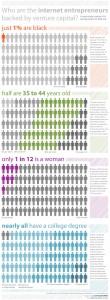Culture. It’s subtle, it’s everywhere, and it can make or break you. Zefer Corp was an internet consulting start-up whose CEO, Tony Tjan (also an HBR.org blogger), deliberately created a culture of youth, hipness, and hard work. Everything from the loftlike space with translucent-walled meeting areas to the young workforce went into the mix. High-caliber job candidates came to Zefer, despite better offers, because the culture itself was such a strong draw.
Culture determines who will work for you, who stays, and who quits. Once formed, culture is nearly impossible to change. People who work well within the culture quickly self-select. And those who don’t fit leave.
In growing companies more than anywhere else, culture is tightly tied to the CEO.
The CEO Sets the Culture.
In a hierarchy, people look up for approval. When a frontline store clerk sneezes, people hand him a tissue. When a CEO sneezes, people rush to the water cooler. “What did that sneeze mean? Was she bored, and sneezing to cover it up?” Deliberately or not, the CEOs actions send constant signals that begin shaping everyone’s behavior.“Walking the talk” is critical for a CEO because people imitate the CEO. If they say one thing and do another, people will follow their actions, not their words. They need to be a living example of the culture they want to create. In a start-up, since everyone has regular contact with the CEO, everything she does signals what is and isn’t OK.
Good CEOs Attend to Visible Culture
CEOs also influence culture with visual cues, for example, the design of the office. Take a home products company that started life in an extremely nice space. It became easy for employees to think they were already successful, and to rather cavalierly burn through their seed money. In contrast, LA-based Evolution Robotics’s CEO stocked the warehouse office with desks made from doors atop filing cabinets. The space itself said “lean and mean,” better than any lecture about cash flow.Dress codes also shape culture. Scott Cook, co-founder of Intuit (makers of Quicken) set a casual tone by wearing jeans and a windbreaker, while tech pioneer Charlie Bachman wore a suit every day at his company. Clothing choices visibly signal attitudes toward formality and conduct.
Other visible signs of culture include work-hour flexibility, telecommuting ability, and so on. In entrepreneurial companies, all policies comprising the visible culture are created with the CEO’s involvement.
Great CEOs Attend to Invisible Culture
Much of culture is invisible, however, in the form of the processes the company uses to get things done. These aspects of culture can be shaped only with deliberate attention. Great CEOs shape the invisible culture.Decision making. Decision making is where a company’s values come to life (or death, depending). When a company is forced to choose between two alternatives, that choice sends everyone a powerful signal about how to behave. It’s easy to say, “we care about quality and we care about profit.” But when forced to choose between shipping a low-quality product to make profit numbers and slipping a ship date until a product is ready for prime time, what actually happens will speak volumes about what this company values most. The CEO is almost always party to such difficult decisions, and can shape them to help shape the culture.
Who participates in decisions also sends a signal. If one function (marketing, finance, customer service) regularly gets their way, the others gradually take second place. If one person speaks just loudly enough to shut everyone else down, you get a culture that values heat over light.
When a company regularly preaches one set of values, and the CEO condones decisions that trumpet a different set of values, you’ll create a cynical culture. One high-tech CEO preached quality but knowingly released defective products and simply budgeted for the subsequent recall. Employees circulated articles extolling the company’s commitment to customers, with handwritten margin comments tallying up the lies.
Compensation. People do what you pay them for, which makes money, titles, and responsibility powerful shapers of culture. A CEO who promotes friends and family member sends a clear message: if you’re a high performer, great. But family comes first, regardless. Young companies are just forming compensation systems. Thoughtful design is important. Tying customer service bonuses to number of calls per hour can cause reps to shortchange customers just to make call quotas. A culture will develop that’s time oriented, rather than customer oriented.
One way compensation warps a culture is by rewarding outcomes over process. For several years in the early 2000s, mortgage lenders’s compensation was tied to outcomes — mortgages written — rather than process (quality underwriting). Oops. Compensation has huge cultural implications, and the CEO has final say on compensation.
Mistake Management. The final piece of invisible culture is how mistakes are handled. If mistakes are punished, you’ll build a risk-averse, sycophantic culture that plays it safe rather than thinking outside the box. If mistakes are treated as learning and supported by the reward systems, you’ll grow a culture that is willing and eager to experiment and innovate.
Stever Robbins is a serial entrepreneur, top-10 iTunes business podcaster (“The Get-it-Done Guy”), and CEO of Stever Robbins, Inc., an entrepreneurial consulting and coaching firm. He teaches at Babson College on building social capital. His first book, The Get-it-Done Guy’s 9 Steps to Work Less and Do More, is coming out this September.
By RYAN STREETER
The past few years have seen no shortage of commentary about the comparative economic environments in China and India, where growth and the rise of enterprising classes have gone hand in hand. Yet we have very little data to help us understand how entrepreneurs in these countries think and what motivates their decisions and actions. A new survey of more than 4,000 entrepreneurs, business managers and aspiring entrepreneurs, conducted by YouGov and released today by the Legatum Institute, sheds light on the countries’ respective enterprising classes—and raises some questions for policy makers and investors.
Entrepreneurs in both countries share a high degree of bullishness. Nearly half of the respondents believe their societies are more welcoming of entrepreneurial activity than they were 10 years ago, and only one-quarter in India and one-third in China believe that the global financial crisis has seriously hampered the prospects for new businesses. The vast majority believe their lives will improve dramatically in the next five years.
…
Indian entrepreneurs paint a more relational and organic picture. Twenty-one percent cite family expectations as the source of their entrepreneurship compared to 9% in China, and 27% of Indians cite the inspiration they glean from knowing another entrepreneur, compared to 18% in China.
This difference in inspiration and motivation manifests itself in many ways. The relational Indian model of business start-ups is evident in enterprise financing, where 49% of business owners rely on family resources to start their enterprise, compared to only 25% in China. Chinese entrepreneurs are much more dependent on banks, with 49% taking out loans compared to 27% in India.
…
There are also significant differences in how entrepreneurs see themselves relating to their policy environments. In India, 81% of business owners say that jugaad, the ability to improvise and find ways around prohibitive rules and institutions, is important to business success. In China, 93% of business owners say guanxi, the networks and relationships (primarily with the state) necessary to succeed in business, are important to their own success. Generally, enterprising individuals in India believe they succeed in spite of the state, while in China they think they succeed through their connections to it.



![[BAstreeter]](http://sg.wsj.net/public/resources/images/AG-AC041_BAstre_NS_20100804111202.gif)
